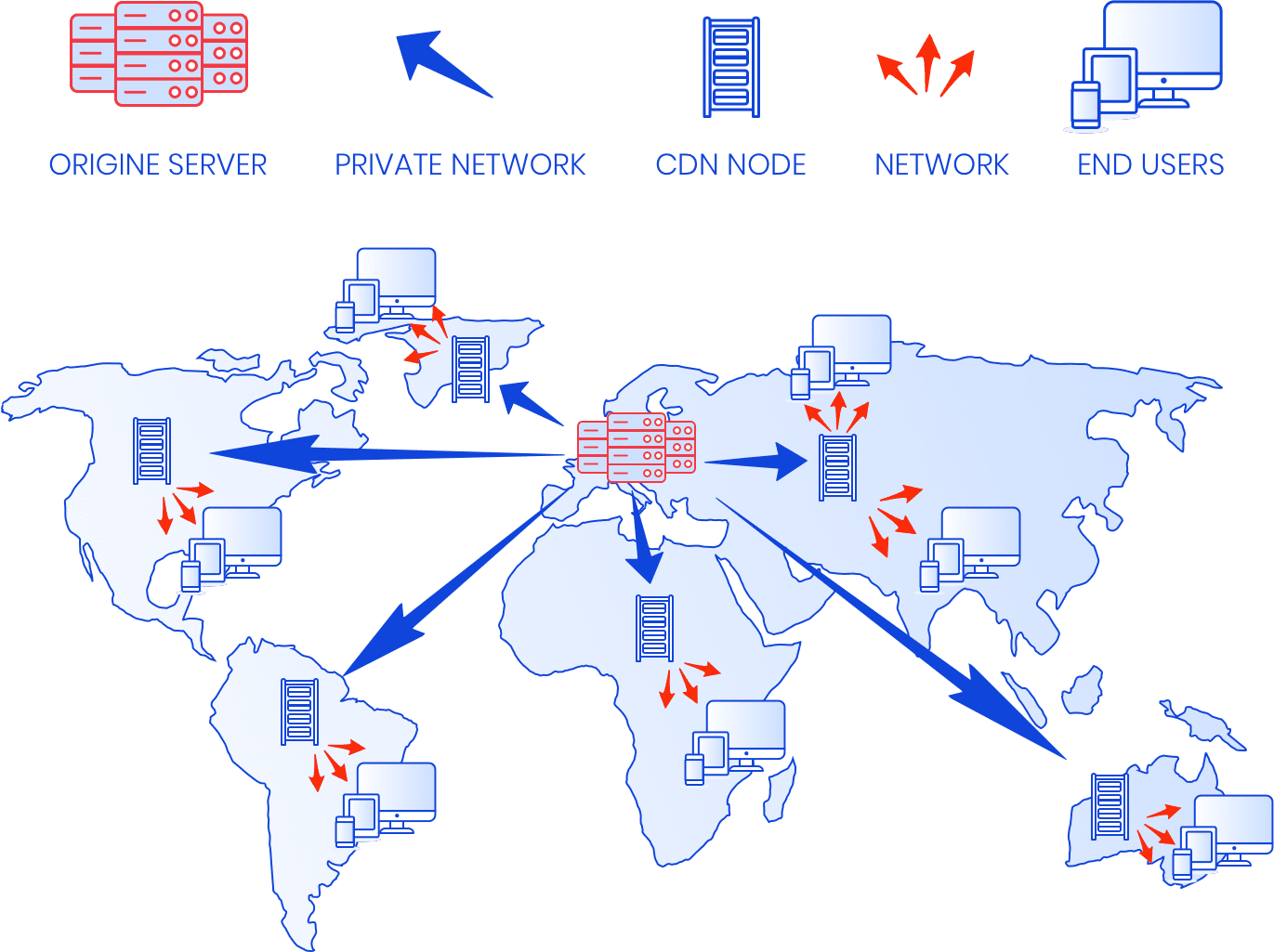Content Delivery Network (CDN)
Maximise the speed and stability of your website and online applications
The speed of your website and applications is crucial for your business. Slowdowns and downtime are simply unacceptable. At the same time, servers and Internet connections are under more pressure than ever before. So how can you guarantee that all your users enjoy the best possible quality experience at all times? It is quite simple: with a Content Delivery Network (CDN) that ensures:
- Ultra-fast loading times
- More stable platforms
- Guaranteed Quality of Experience (QoE)



What is a CDN (Content Delivery Network)?
A Content Delivery Network (CDN) is a network of proxy servers distributed worldwide, whose purpose is to deliver web content to end users as quickly as possible. The requested content on the application server is delivered to users via a local PoP (Point of Presence), which consists of several proxy servers.
A CDN uses geolocation technology. When a user requests a certain content, the content delivery infrastructure will determine which PoP should be used to deliver the content. The distance between the user and the PoP plays a role, as does the available capacity of the PoP. The fastest possible connection will always be chosen. This will keep the loading time to a minimum, even in the event of major traffic peaks.
The benefits of a CDN
A Content Delivery Network has many benefits, both for your organisation and for the end users of your application or the visitors of your website.
-
Faster loading times
The content delivery infrastructure selects the best performing PoP at any time. As a result, the content is delivered much faster, even when many users are active at the same time.
-
More stable platforms
Users access the fastest CDN PoP, which reduces the load on the central server. This keeps your website or application stable, even when traffic peaks.
-
Better Quality of Experience
The loading speed of an application is an important factor for the quality of experience of an application or website. A CDN guarantees fast loading times and an optimal Quality of Experience.
-
Satisfied customers
A stable platform with guaranteed high loading speed makes end users happy. And that is good for your business!
A CDN is particularly interesting if your users are located in different parts of the world.
How does a CDN work?
CDN technology uses reverse (caching) proxy servers located between the user and the application server.
A user requests content.
A reverse proxy server accepts the user's request. Initially, the user does not have the content and forwards the request to the application server.
The application server then sends the content to the proxy server that delivers the information to the user.
The proxy server caches the content of the application server and stores this information for a certain period of time.

The user has the impression that he/she is accessing an ordinary server. The application server also thinks that a proxy server is an ordinary user. CDN technology is very similar to HTTP caching technology.
A smart selection mechanism selects the fastest PoP
Different techniques are used to select the fastest PoP.
The user's IP address helps determine which POP is closest to the user.
Border Gateway Protocol (BGP) will always choose the fastest path to reach the destination. When a user submits a request to a service using Anycast, BGP chooses the best possible path among the servers available within the Anycast network.
Would you like to find out more about the operation and the benefits of a CDN?
What does a CDN do?
A Content Delivery Network does much more than just caching static files:
- Processing of incoming HTTP requests and outgoing HTTP responses
- Provision of an interface that makes it possible to define complex caching rules
- Image optimisation
- CSS & JavaScript optimisation
- Conversion of video files to OTT streaming video
- Protection of the application server against malicious requests by means of a web application firewall (WAF)
- Protection of the domain name against DNS-based attacks
- Monitoring and reporting of the behaviour of the cached platform
- Provision of an authentication gateway to protect content from unauthorised access.
- Edge computing: logic processing is performed by the CDN, which significantly reduces the load on the application server and ensures stability.
Different types of CDNs
Traffic swings are quite a common phenomenon on the Internet, partly due to the presence of CDNs.
Popular online content that suddenly becomes available can indeed quickly overload CDN PoPs. Think, for example, of viral videos or updates to online games such as Call of Duty. This kind of content can easily cause a large number of CDN PoPs to become completely overloaded. In order to avoid delaying the rest of the Internet traffic, the content in question will be redirected to other CDN PoPs.
A multi-CDN will look for a PoP that is not affected by such a traffic swing. It is the ideal strategy if you want to reduce the risk of downtime and slow loading speeds.
A standard CDN is a shared service. As a customer, you have no control over it. Moreover, the costs can increase exponentially as you use large amounts of data and bandwidth to serve your users.
This is why more and more companies are building their own CDN. This helps keep costs predictable, particularly for companies that have a local connection or that operate in locations where no (good) CDN PoPs are available.
Does your company have its own data centre or network capacity? If so, having its own CDN is a smart and predictable way to serve local users.
An increasing number of companies are opting for a hybrid solution:
- Local CDN to serve their users locally
- Multi-CDN for global coverage to handle major traffic peaks
When many proxy servers want to revalidate their content at the same time, this can cause a DDoS effect on the application server, making it temporarily inaccessible. The local CDN then acts as a defensive shield ("origin shield"), protecting the application server from this phenomenon.
Rely on our CDN experts

Together with you, we look for the best solution. Our experienced specialists guarantee a professional and high-quality implementation of your CDN on your managed server.




